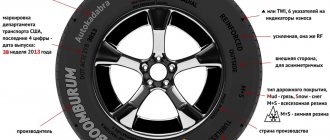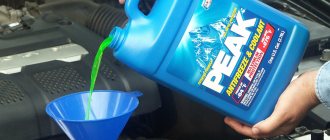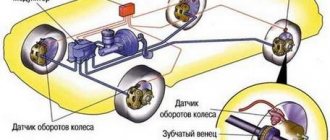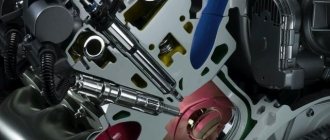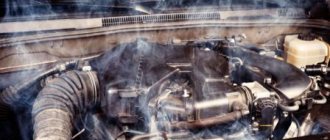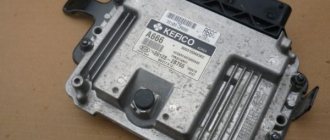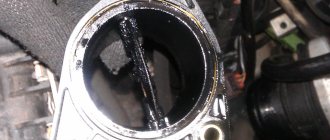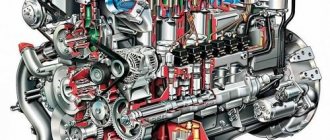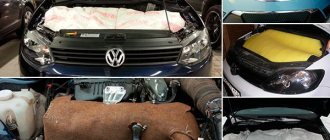October 14, 2020
Engine braking of a car is a rather useful technique, which, according to experienced drivers, is necessary for every car enthusiast. But what is engine braking? How to do this correctly? What are the pros and cons of engine braking? Now we'll tell you. The information will be useful for both beginners and experienced drivers - it will allow them to learn something new.
What is engine braking
Engine braking of a car is slowing down the movement without using the car's braking system. Here you no longer need to press the brake pedal. The speed decreases when the gear is engaged and the accelerator pedal is released. This method of stopping is also called “forced idle.”
In practice it looks something like this. The car is moving at speed. At a decent distance to a traffic light with a red signal, the driver stops pressing the gas, and the car moves by inertia, gradually slowing down. And before the intersection, the driver smoothly presses the brake and the car stops.
The benefits of engine braking
There are many advantages to this process. The main ones are:
- Less danger of skidding on wet and slippery highways
. There is no wheel locking, which, in turn, reduces the likelihood of losing control of the car. As a result, the car drives smoothly and its stability on slippery or wet surfaces increases. With sufficient experience, even if the adhesion of the wheels to the road surface is poor, then using this method you can maneuver effectively and confidently. - Fuel economy
. Most often used to move a car in urban environments. Fuel is no longer needed here. Also, with frequent braking, there is less wear on tires and brake pads. - When traveling in mountainous areas
. In this situation, as a rule, the goal is to reduce significant overheating of the pads during intensive use. However, if you need to brake quickly, it is recommended to immediately apply the brakes rather than try to stop using the method discussed. - The brake system does not work
. If the brakes fail while driving, then, of course, you need to know an alternative method to safely stop the car. In this case, we can talk about problems with the brake pads or lack of brake fluid. Also, some experienced drivers successfully move a car with faulty brakes over certain distances if it is not possible to use the services of a tow truck.
Engine braking pros and cons
pros
- Provides smooth vehicle deceleration on any surface
- Does not allow the car to gain speed when descending steep mountains
- Protects brake system elements - discs and pads, reducing their wear and prompt replacement
- Fuel economy. With this type of braking, gasoline does not enter the combustion chambers of the engine, which means it is not consumed
- Since there are no flashes in the internal combustion engine cylinders, they are blown with cold air, reducing the engine temperature
- You can safely brake before turning on icy or packed snow
Minuses
If the minimum speed is not observed, the engine may stall. Beginners are especially afraid of this. If you feel that the engine speed is not sufficient to maintain it idling, depress the clutch pedal
Incorrect gear changes during engine braking can damage the clutch disc and basket. How to avoid this is explained above
The rear brake lights do not light up, the driver behind will not understand that they have started to slow down.
Disadvantages of engine braking
The braking option under discussion also has its drawbacks. There are few of them, but they still exist:
- The risk of emergency situations increases
. This is because the brake lights do not come on during the specified deceleration. Accordingly, drivers of cars driving behind may not notice that the vehicle in question is losing speed and may not draw the appropriate conclusions from this. - The wear of mechanisms increases
. The motor does not tolerate reverse loads very well. And since modern engines have asymmetrically placed pistons, during the said braking the lateral loads increase. Also, for example, the load on the intake manifold increases, which increases the wear of the ventilation system. - Oil consumption increases
. Practice shows that if you can save on something during the process under discussion, then the situation with oil is different. Its consumption, on the contrary, increases. - The likelihood of skidding increases
. Although engine braking of a car is often used precisely on slippery roads, if even one action is performed incorrectly, the car can skid much more than expected.
Pros and cons of engine braking
The main advantage of engine braking is that the car is protected from skidding than if the wheels were stopped. When a wheel locks, the car becomes uncontrollable for some time and everything depends on the adhesion of the rubber to the road surface. On slippery roads, even cars with ABS (ABS - anti-lock braking system) do not always protect against skidding.
Therefore, it is very important to be able to brake with your engine. I used this kind of braking when descending steep slopes where there was not even asphalt.
If the brakes are weak, for example, the linings on the pads or linings on the disc brakes have worn out, then engine braking has to be used even if the road is dry.
The disadvantage of engine braking is that cars behind may not immediately realize that you are braking with the engine, because the rear brake lights do not light up, and why would they light up if the brake pedal is not pressed.
How to properly brake with an automatic transmission
If we are talking about how to properly brake the engine on a car with an automatic transmission, then everything is quite simple. You just need to take your foot off the accelerator pedal, and then the machine itself will downshift in the required sequence.
But this algorithm does not work on all machines; there are exceptions. You can read about this in the instructions for the specific model. For example, there are automatic transmissions in which, in order to achieve the goal under discussion, you first need to turn on the overdrive mode, then, when reaching a certain speed, alternately switch first to D2, and then, when the speed decreases, to L.
In this case, at first the speed should not exceed 92 km/h, and then the transition to D2 is made when driving up to 54 km/h. In addition, in some cases, when driving an automatic, you just need to use the manual mode.
How to properly brake with a manual transmission
It is not difficult to carry out the specified braking of a car driving on a manual transmission, but there are enough nuances here. There are two main methods - standard and gas. In the first option, you need to release the gas pedal, press the clutch, then engage third gear, and then, as the speed decreases, switch to second and first.
Moreover, when using a high gear, it is recommended to switch to a lower gear only through third. If you immediately shift to a low gear, the wheels may lock and the car will spin. In addition, a large load will be immediately placed on the engine and gearbox, which may cause them to fail ahead of time.
Therefore, experienced drivers most often use throttle braking, since it is more gentle on the main components of the car. This method boils down to the fact that when switching to lower gears, the clutch is first depressed, then the gearbox is moved to neutral, then the driver gives a little gas, and only then does he engage a lower gear.
Here you should remember the rule: in any case, you cannot immediately switch from high gear to first. Also, the clutch pedal is depressed very smoothly and only when there is a connection between the engine and transmission.
How to brake with a manual engine correctly
The deceleration mode of the engine and gearbox depends on the situation in which the car is located. More precisely, on the conditions of the road surface. For example, when driving on a flat road, engine braking will be different from driving down a mountain or on ice. Let's look at each mode in detail.
Rectilinear movement on a flat surface
These are the most ideal conditions. Drive along the highway in fifth gear. There is a turn or obstacle ahead. To apply engine braking, just release the gas pedal without pressing the clutch or changing gear.
The power unit remains in rigid coupling with the driving wheels of the vehicle. Since the fuel supply stopped when the gas pedal was released, the engine begins to “consume” energy. Torque is transmitted through the gearbox from the wheels to the crankshaft. Due to friction in the internal combustion engine and compression in the cylinders, this moment gradually fades away and the car begins to slow down smoothly. All this happens without the participation of brake mechanisms.
Important! It is worth remembering that when you start braking with the engine, the brake lights do not light up, so the driver behind the moving car will not understand that you have started to slow down. This may lead to an accident. It is recommended to use deceleration by the gearbox and motor with the brake pedal in combination. It is enough to press the pedal lightly to signal to other road users that you intend to slow down.
If at this moment you “squeeze” the clutch, the connection between the gearbox and the engine will be broken, the internal combustion engine will go into idle mode and the braking process will be interrupted. To continue it again, you need to smoothly move the clutch pedal until it “snaps” and release it. Don't forget about the speed of the car. If it is less than 20 km/h, the engine may stall. Therefore, it is recommended to use this maneuver at high speeds.
Let's go down the mountain
When descending a mountain, it is recommended to brake with a manual engine in lower gears. As mentioned above, if you do this in high gear, the efficiency will be low, the car will slow down smoothly and there is a chance that it will not fit into the turn. This is especially true on mountain serpentines.
The steeper the descent, the lower the gear should be. This allows you to reduce speed faster without using the brakes. When your route passes through a mountain range or where the road frequently rises and falls, if you constantly use the brakes, they will overheat and fail.
To downshift:
- Depress the clutch
- Downshift
- Use the gas pedal to raise the engine speed to 2500-3000 rpm. Smoothly release the clutch pedal. This way, you will “bring up” the engine speed to the speed of the input shaft of the manual transmission and there will be no impact on the clutch disc. You will protect the mechanism from damage
- Release the gas pedal. You started to slow down with your engine.
Remember, the steeper the descent, the lower the gear should be.
A case from one's life. I had the opportunity to travel to the New World along the Crimean serpentines, where the descent was replaced by a sharp uphill through a sharp turn. I was driving in third gear, which was enough for me to use the brake pads minimally and slow down in time before the turn. Unfortunately, on such turns I often came across cars in a ditch - these were those who neglected the recommendations for effective braking with the gearbox and engine in mountainous areas and frequent use of the brakes.
We brake the internal combustion engine on ice or compacted snow
Engine braking on slippery roads in winter is an important skill that will protect you from skidding or drifting. It differs from the two modes described above. It is worth remembering that there is ice under the wheels, so the car’s behavior will be different.
Rules for how to properly slow down with a motor on ice:
- Do not suddenly release the gas pedal. This will lead to wheel slip and loss of traction.
- Do not release the clutch pedal sharply when switching to lower gears during engine braking. The car may skid. Because the wheels will sharply transmit torque to the motor, and since there is ice under them, their rotation speed will quickly drop. This is the equivalent of slamming on the brakes.
Important! On icy conditions, we select the optimal speed in order to have time to brake and drive in lower gears. This will make it possible to make the most of the engine deceleration and not waste time switching gears from high to low.
